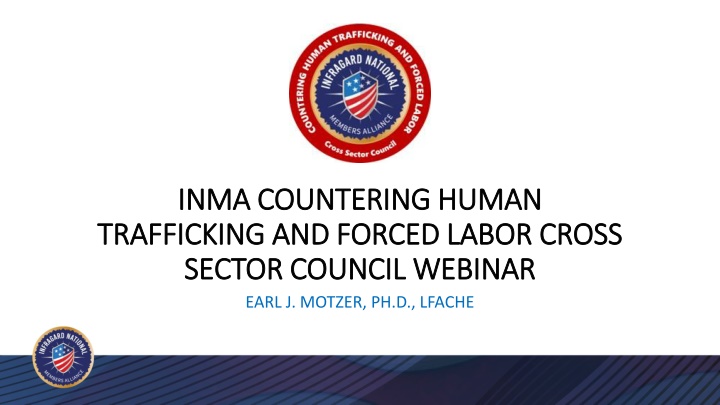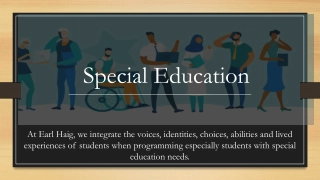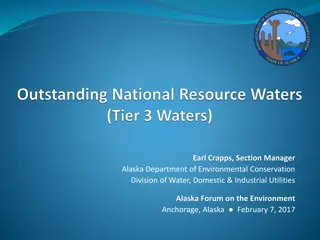
Human Trafficking: Key Insights and Strategies for Prevention
Explore crucial information on human trafficking, including definitions, statistics, victim profiles, and the mission of organizations combating this criminal activity. Discover ways to identify potential victims and where to report suspicions, debunk myths, and educate yourself on the psychological and behavioral aspects of trafficking. Join the fight against human trafficking and forced labor by gaining valuable knowledge and insights from experts in the field.
Download Presentation

Please find below an Image/Link to download the presentation.
The content on the website is provided AS IS for your information and personal use only. It may not be sold, licensed, or shared on other websites without obtaining consent from the author. If you encounter any issues during the download, it is possible that the publisher has removed the file from their server.
You are allowed to download the files provided on this website for personal or commercial use, subject to the condition that they are used lawfully. All files are the property of their respective owners.
The content on the website is provided AS IS for your information and personal use only. It may not be sold, licensed, or shared on other websites without obtaining consent from the author.
E N D
Presentation Transcript
INMA COUNTERING HUMAN INMA COUNTERING HUMAN TRAFFICKING AND FORCED LABOR CROSS TRAFFICKING AND FORCED LABOR CROSS SECTOR COUNCIL WEBINAR SECTOR COUNCIL WEBINAR EARL J. MOTZER, PH.D., LFACHE
PRESENTATION SLIDE CONTENTS INMA CROSS SECTOR COUNCIL MISSION DEFINITIONS HUMAN TRAFFICKING STATISTICS WHO ARE MOST VULNERABLE HOW TRAFFICKERS LURE PEOPLE RECOGNIZING LABOR TRAFFICKING RECOGNIZING SEX TRAFFICKING WHERE TO REPORT MINDSET OF A TRAFFICKING VICTIM PSYCHOLOGICAL AND BEHAVIORAL CLUES MYTHS QUESTIONS & COMMENTS & THANKS 3 4 5 6 7 9 11 13 14 15 17 27 2
INMA CSC MISSION Expand knowledge of 86,000+ InfraGard members about this criminal activity to include ways of recognizing possible victims and where to timely report this suspicion. Briefings on various aspects of this criminal activity and other resources will be made available to InfraGard Members Alliances (IMAs) for their members. Partnerships with other related government and private sector organizations in their areas of responsibility should be encouraged for mutual support and greater public awareness. 3
DEFINITION- HUMAN TRAFFICKING AND VICTIMS Human trafficking is generally understood to mean the recruitment, harboring, transportation, provision, obtaining, patronizing, or soliciting of a person for the purpose of a commercial sex act (sex trafficking) in which a commercial sex act is induced by force, fraud or coercion, or in which the person induced to perform such act has not attained 18 years of age: and the recruitment, harboring, transportation, provision, or obtaining of a person for labor or labor through the use of force, fraud or coercion for the purpose of subjection to involuntary servitude, peonage, debt bondage, or slavery. Victims of human trafficking can be young children , teenagers, men and women. They can be U.S. citizens, Lawful Permanent Residents (LPRs) or foreign nationals, and they can be found in urban, suburban, and rural areas. Minors (under the age of 18) who are induced to perform commercial sex acts are victims of trafficking, regardless of whether their traffickers used force, fraud of coercion. 4
HUMAN TRAFFICKING STATISTICS International Labor Organization's most current global estimate in 2021 indicates: 27.6 million people are adversely affected 3.3 million of which are children 5 to 17 years of age. 5
WHO IS MOST VULNERABLE? While it can happen to anyone, evidence suggests that people of color and LGBTQ+ people are more likely to be vulnerable. Traffickers recognize and take advantage of vulnerable people who: Have an unstable living situation; Have previously experienced other forms of violence such as sexual abuse or domestic violence; Have run away or are involved in juvenile justice or child welfare system; Are undocumented immigrants; Are facing poverty or economic need; Have a caregiver or family member who has a substance issue; Are addicted to drugs or alcohol. 6
HOW TRAFFICKERS LURE PEOPLE Stories become weapons in the hands of human traffickers tales of romantic love everlasting or about good jobs and fair wages just over the horizon. Sometimes, the stories themselves raise red flags. Other times, traffickers or potential traffickers may raise red flags during recruitment: A would-be employer refuses to give workers a signed contract or asks them to sign a contract in a language they can t read; A would-be employer collects fees from a potential worker for the opportunity: to work in a particular job. A friend, family member, co-worker, or student is newly showered with gifts or money or otherwise becomes involved in an overwhelming, fast moving and asymmetric (e.g., large difference in age or financial status) romantic relationship; 7
HOW TRAFFICKERS LURE PEOPLE (cont) Or is developing a relationship that seems too close with someone known solely on social media. A friend, family member, or student is a frequent runaway and may be staying with someone who is not a parent or guardian; or Lives with a parent or guardian and shows signs of abuse. A family member, friend or co-worker is offered a job opportunity that seems too good to be true; or Is recruited for an opportunity that requires them to move far away, but their recruiter or prospective employer avoids answering their questions or is reluctant to provide detailed information about the job. 8
RECOGNIZING LABOR TRAFFICKING Labor trafficking includes situations where men, women, and children are forced to work because of debt, immigration status, threats and violence. Keeping victims isolated physically or emotionally is a key method of control in most labor trafficking situations. That does not mean you never cross paths with people who are experiencing trafficking: Feel pressured by their employer to stay in a job or situation they want to leave; Owe money to an employer or recruiter or are not paid what they were promised or are owed; Do not have control of their passport or other identity documents. 9
RECOGNIZING LABOR TRAFFICKING (cont) Are living and working in isolated conditions, largely cut off from interaction with others or support systems; Appear to be monitored by another person when talking or interacting with others; Are being threatened by their boss with deportation or other harm; Are working in dangerous conditions without proper safety gear, training, adequate breaks, or other protections; Are living in dangerous, overcrowded, or inhumane conditions provided by an employer. 10
RECOGNIZING SEX TRAFFICKING Sex trafficking occurs when individuals are made to perform commercial sex through used of force, fraud or coercion. Any child under 18 who is involved in commercial sex is legally a victim of trafficking, regardless of whether there is a third party involved. People may be experiencing sex trafficking if they: Want to stop participating in commercial sex but feel scared or are unable to leave the situation; Disclose they were reluctant to engage in commercial sex but someone pressured them into it; 11
RECOGNIZING SEX TRAFFICKING (cont) Live where they work or are transported by guards between home and workplace; Are children who live with or are dependent on a family member with a substance use problem or who is abusive; Have a pimp or manager in the commercial sex industry; Work in an industry where it may be common to be pressured into performing sex acts for money, such as a strip club, illicit cantina, go-go bar, or illicit massage business. Have a controlling parent, guardian, romantic partner, or sponsor who will not allow them to meet or speak with anyone alone or who monitors their movements, spending, or communications. 12
WHERE TO REPORT DHS CENTER FOR COUNTERING HUMAN TRAFFICKING TIP LINE 1-866-347-2423 or https//go.usa.gov/xMGSg REQUEST HELP TODAY 1-888-373-7888 CALL 911 IN AN EMERGENCY SITUATION REPORT SUSPECTED FORCED LABOR TRADE VIOLATIONS eAllegations.cbp.gov/Home/allegation ALSO, INFORM YOUR FBI IMA PSC FOR INFORMATION SHARING PURPOSES 13
MINDSET OF TRAFFICKING VICTIMS May develop a mindset of fear, distrust, denial, and conflicting loyalties. Foreign victims are often fearful of being deported or jailed and, therefore, they may distrust authority figures, particularly government and law enforcement officials. Similarly, traffickers may convince sex trafficking victims who are U.S. citizens or Lawful Permanent Residents that, if they report their traffickers to the police, the police will jail the victim for prostitution while the traffickers, pimps or johns will go free. Many victims of both sex and labor trafficking fear that, if they escape their servitude and initiate investigations against their trafficker, the trafficker and his/her associates will harm the victims, the victims families, or other. 14
PSYCHOLOGICAL AND BEHAVIORAL CLUES Develop general feelings of helplessness, shame, guilt, self-blame, and humiliation; Suffer from shock and denial, or display symptoms of post-traumatic stress disorder. phobias, panic attacks, anxiety, and depression; Suffer from sleep or eating disorders; Become addicted to drugs and/or alcohol as a way to cope with or escape their situation, or as a method of control used by their traffickers; 15
PSYCHOLOGICAL AND BEHAVIORAL CLUES (cont) Become emotionally numb, detached, and disassociated from the physical and psychological trauma and display flat affect ; Experience trauma bonding with the trafficker, possibly identifying with the trafficker and believing that, despite repeated abuse, the trafficker is a loving boyfriend, spouse, or parent. 16
MYTH ITS ALWAYS OR USUALLY A VIOLENT CRIME? Reality Most human traffickers use psychological means such as tricking, defrauding, manipulating or threatening victims into providing commercial sex or exploitative labor. 17
MYTH ONLY UNDOCUMENTED FOREIGN NATIONALS GET TRAFFICKED IN THE USA Reality Investigators have worked on thousands of cases of trafficking involving foreign national survivors who are legally living and/or working in the United States. These include survivors of both sex and labor trafficking. 18
MYTH ONLY WOMEN AND GIRLS CAN BE VICTIMS AND SURVIVORS OF SEX TRAFFICKING Reality One study estimates that as many as half of sex trafficking victims and survivors are male. Advocates believe that percentage may be even higher but that males are far less likely to be identified. LGBTQ boys and young men are seen as particularly vulnerable to trafficking. 19
MYTH HUMAN TRAFFICKING ONLY HAPPENS IN ILLEGAL OR UNDERGROUND INDUSTRIES Reality Human trafficking cases have been reported and prosecuted in industries including restaurants, cleaning services, construction, factories and more. 20
MYTH HUMAN TRAFFICKING INVOLVES MOVING, TRAVELING OR TRANSPORTING A PERSON ACROSS STATE OR NATIONAL BORDERS. Reality Human trafficking is often confused with human smuggling, which involves illegal border crossings. In fact, the crime of human trafficking does not require any movement whatsoever. Survivors can be recruited and trafficked in their own home towns, even their own homes. 21
MYTH TRAFFICKERS TARGET VICTIMS THEY DONT KNOW Reality Many survivors have been trafficked by romantic partners, including spouses, and by family members, including parents. 22
MYTH ALL COMMERCIAL SEX IS HUMAN TRAFFICKING Reality All commercial sex involving a minor is legally considered human trafficking. Commercial sex involving an adult is human trafficking if the person providing commercial sex is doing so against his or her will as a result of force, fraud or coercion. 23
MYTH PEOPLE BEING TRAFFICKED ARE PHYSICALLY UNABLE TO LEAVE THEIR SITUATIONS/ LOCKED IN/ HELD AGAINST THEIR WILL Reality That is sometimes the case. More often, however, people in trafficking situations stay for reasons that are more complicated. Some lack the basic necessities to physically get out such as transportation or a safe place to live. Some are afraid of their safety. Some have been so effectively manipulated that they do not identify at that point as being under the control of another person. 24
MYTH LABOR TRAFFICKING IS ONLY OR PRIMARILY A PROBLEM IN DEVELOPING COUNTRIES Reality Labor trafficking occurs in the United States and in other developed countries but is reported at lower rates than sex trafficking. 25
MYTH IF THE TRAFFICKED PERSONS CONSENTED TO BE IN THEIR INITIAL SITUATION, THEN IT CANNOT BE HUMAN TRAFFICKING OR AGAINST THEIR WILL BECAUSE THEY KNEW BETTER Reality Initial consent to commercial sex or a labor setting prior to acts of force, fraud or coercion (or if the victims are minors in a sex trafficking situation) is not relevant to the crime, nor is payment. 26
QUESTIONS AND COMMENTS THANK YOU FOR YOUR ATTENTION 27






















